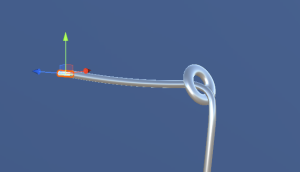30-08-2023, 10:57 PM
Hi,
My goal is to create a series of rings where the user needs to drag the rope through. The end of the rope is attached to a rigid body that can be controlled.

However, the rope often penetrates the rings. This even happens when the rigid body is moving very slowly.
I have tried so far to increase the sub-steps of the updater (to 20), and increase the iterations of the distance/collision constraints (I increased them to 15 separately). Their effects are not really observable. Increasing the number of particles did not lead to positive results either (as the surface collision has always been on).
I understand that this 'tunneling' issue is very difficult to solve, but by any chance are there other solutions for me to explore?
If there is none, the first trick that I can think of is to create the rings with obi ropes, rather than thin shell meshes. However, how can I stop the rope rings from moving? As I understand, disabling the ropes would remove the particles from the solver, and therefore no more collision detection.
Another way to cheat is to add a constraint that says one of the particles has to be at the centre of the ring with the same orientation, but how can I add such a constraint to the solver (if possible)?
Many thanks in advance!
My goal is to create a series of rings where the user needs to drag the rope through. The end of the rope is attached to a rigid body that can be controlled.
However, the rope often penetrates the rings. This even happens when the rigid body is moving very slowly.
I have tried so far to increase the sub-steps of the updater (to 20), and increase the iterations of the distance/collision constraints (I increased them to 15 separately). Their effects are not really observable. Increasing the number of particles did not lead to positive results either (as the surface collision has always been on).
I understand that this 'tunneling' issue is very difficult to solve, but by any chance are there other solutions for me to explore?

If there is none, the first trick that I can think of is to create the rings with obi ropes, rather than thin shell meshes. However, how can I stop the rope rings from moving? As I understand, disabling the ropes would remove the particles from the solver, and therefore no more collision detection.
Another way to cheat is to add a constraint that says one of the particles has to be at the centre of the ring with the same orientation, but how can I add such a constraint to the solver (if possible)?
Many thanks in advance!




